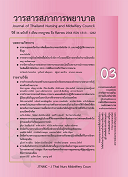Predictors of Need for Mechanical Ventilator Use in Critically Ill Surgical Patients
Keywords:
need for mechanical ventilator use, critically ill surgical patients, predictors, intensive care unit, Roy adaptation modelAbstract
Objective: To examine the predictive power of surgery type, level of consciousness, principal diagnosis, and number of comorbidities to a need for mechanical ventilator use among critically ill surgical patients.
Design: Retrospective predictive cross-sectional study
Methodology: The samples were 111 patients who aged 18 years and over, received surgery under general anesthesia and admitted to Intensive Care Unit (ICU). Roy Adaptation Model was applied as a conceptual framework of the study. The researcher gathered retrospective data by reviewing patient’s medical records. The research instruments included demographic, clinical, and studied factors data record forms. Binary Logistic Regression with enter method was employed for predictive power analysis.
Results: The samples had average age of 59.8 years (SD=17.4). 64.9% of them were males. It revealed that only surgery type and level of consciousness could significantly predict a need for mechanical ventilator use. Compared to patients received elective surgery, patients receiving emergency surgery had 2.94 times higher risk of the need for mechanical ventilator use longer than 48 hours (OR=2.939, 95%CI=1.002-8.621, p=.05). Patients with low level of consciousness (Glasgow coma score: GCS ≤ 8) had 4.77 times higher risk of the
need for mechanical ventilator use longer than 48 hours compared to patients with high to moderate level of consciousness (GCS > 8) (OR=4.771, 95%CI=1.641-13.868, p<.01). The predictive model could explain the variance for 21.6% (Nagelkerke R2=.216).
Recommendations: Critically ill surgical patients, who receive emergency surgery and have low level of consciousness (GCS ≤ 8), are more likely to report the need for mechanical ventilator use longer than 48 hours than any other groups. Their respiratory system might manifest ineffective response as an effort to maintain an equilibrium in oxygenation describing by Roy Adaptation Model. Critical care nurses should plan to assess these influential factors in order to provide nursing therapeutics that help promoting effective oxygenation adaptation, reduce the need for mechanical ventilator use, and prevent pulmonary complication in those groups of patients.
References
Kongsayreepong S, Chittawatanarat K, Thawitsri T, Chatmongkolchart S, Morakul S, Wacharasint P, et
al. A multi-center Thai university-based surgical intensive care units study (THAI-SICU study): outcome of ICU care and adverse events. J Med Assoc Thai 2016;99(Suppl6):S1-14.
Miskovic A, Lumb AB. Postoperative pulmonary complications. Br J Anaesth 2017;118(3):317-34. 3. Xu Y, Lai C, Xu G, Meng W, Zhang J, Hou H, et al. Risk factors of ventilator-associated pneumonia in elderly patients receiving mechanical ventilation. Clin Interv Aging 2019;14:1027-38.
Wu D, Wu C, Zhang S, Zhong Y. Risk factors of ventilator-associated pneumonia in critically ill patients. Front Pharmacol 2019;10:482. doi:10. 3389/fphar.2019.00482.
Li Y, Liu C, Xiao W, Song T, Wang S. Incidence, risk factors, and outcomes of ventilator-associated pneumonia in traumatic brain injury: a meta-analysis. Neurocrit Care 2020;32(1):272-85.
Gupta S, Fernandes RJ, Rao JS, Dhanpal R. Perioperative risk factors for pulmonary complications after noncardiac surgery. J Anaesthesiol Clin Pharmacol 2020;36(1):88-93.
Piotto RF, Ferreira FB, Colósimo FC, Silva GS, Sousa AG, Braile DM, et al. Independent predictors of prolonged mechanical ventilation after coronary artery bypass surgery. Rev Bras Cir Cardiovasc 2012;27:520–8.
Roy C. The Roy adaptation model. 3rd ed. Upper Saddle River (NJ): Pearson; 2009.
Ursavas FE, Karayurt O, Iseri O. Nursing approach based on Roy adaptation model in a patient undergoing
breast conserving surgery for breast cancer. J Breast Health 2014;10(3):134-40. doi:10.5152/ tjbh.2014.1910.
Carroll K, Frey-Moylan G. Nursing perspectives and knowledge with an acuity adaptable model. Nurs
Sci Q 2020;33(2):128-31. doi:10.1177/0894318419901283.
Lumb AB, Thomas CR. Nunn and Lumb’s applied respiratory physiology. 9th revised ed. eBook. London (UK): Elsevier Health Sciences; 2020.
West JB, Luks AM. West’s respiratory physiology: the essentials. 11th ed. Philadelphia: Wolters Kluwer; 2020.
Jung YT, Kim MJ, Lee JG, Lee SH. Predictors of early weaning failure from mechanical ventilation in critically ill patients after emergency gastrointestinal surgery: a retrospective study. Medicine 2018; 97(40):e12741. doi:10.1097/MD.00000000 00012741.
Hooda B, Chouhan RS, Rath GP, Lamsal R, Bithal PK. Incidence and predictors of postoperative pulmonary complications in patients undergoing craniotomy and excision of posterior fossa tumor. J Anaesthesiol Clin Pharmacol 2019;35(2):254-60.
Canet J, Gallart L, Gomar C, Paluzie G, Vallès J, Castillo J, et al. Prediction of postoperative pulmonary
complications in a population-based surgical cohort. Anesthesiology 2010;113(6):1338-50.
Othman HA, Gamil NM, Elgazzar AE, Fouad TA. Ventilator associated pneumonia, incidence and risk
factors in emergency intensive care unit Zagazig university hospitals. Egypt J Chest Dis Tuberc 2017;66(4):703-8.
Jin Y, Xie G, Wang H, Jin L, Li J, Cheng B, et al. Incidence and risk factors of postoperative pulmonary complications in non-cardiac Chinese patients: a multicenter observational study in university hospitals.
Biomed Res Int 2015;2015:265165. doi:10. 1155/2015/265165.
Woothisarn Y, Watthanachi T, Tareepian N, Soontornjamorn P. Factors associated with weaning-times
in a medical ward. Journal of Nursing and Health Care 2016;34(4):89-96. (in Thai)
Thanajronpath S, Wonganan U, Sirikul S, Kanchanabothsaya C, KlinKajorn U. The development of program and the effectiveness of weaning ventilator protocol on success of weaning and duration of mechanical ventilator in patients with traumatic brain injury. Journal of Nursing and Health Care 2015; 33(2):83-91. (in Thai)
Chayaput P, Utriyaprasit K, Bootcheewan S, Thosingha O. Coping and health problems of caregivers of
survivors with traumatic brain injury. Aquichan 2014; 14(2):170-83.
Faul F, Erdfelder E, Buchner A, Lang AG. Statistical power analyses using G*Power 3.1: tests for correlation
and regression analyses. Behav Res Methods 2009; 41(4):1149-60. doi:10.3758/BRM.41.4.1149.
Pituch KA, Stevens JP. Applied multivariate statistics for the social sciences: analyses with SAS and IBM’s
SPSS. 6th ed. New York: Routledge; 2016.
Mahmood K, Eldeirawi K, Wahidi MM. Association of gender with outcomes in critically ill patients. Crit
Care 2012;16(3):R92. doi:10.1186/cc11355






